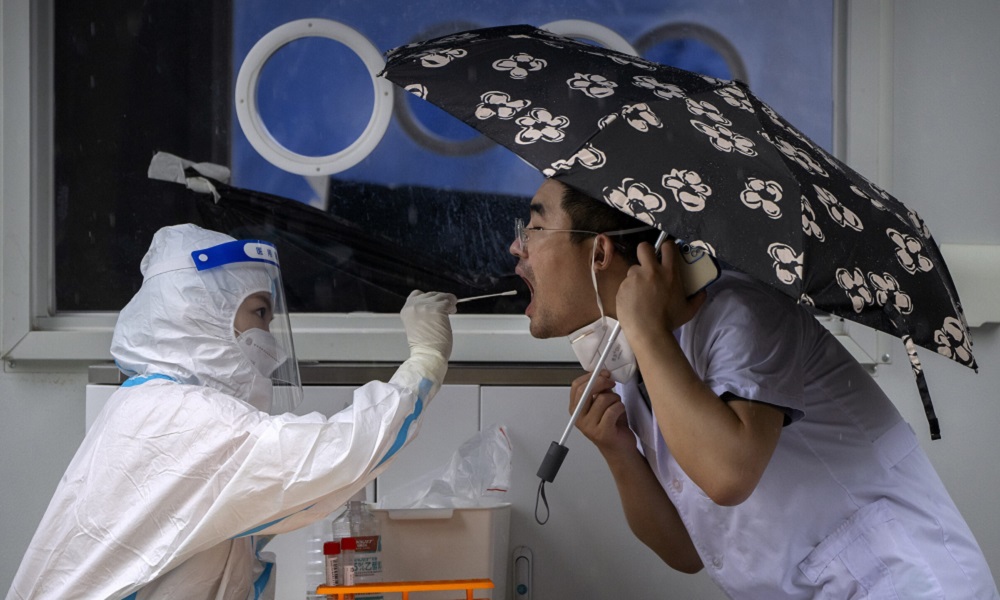COVID-19
China eases some quarantine for travelers even as cases rise

Travelers arriving in China will spend less time in quarantine under changes to sweeping anti-virus controls announced Friday to reduce disruption to the economy and society.
The announcement came even as an upsurge in COVID-19 cases prompted Beijing to close parks and impose other restrictions. The country reported 10,729 new cases, and more than 5 million people were confined to their homes in the southern manufacturing hub Guangzhou and the western megacity Chongqing, AP reported.
With the bulk of Beijing’s 21 million people undergoing near daily testing, another 118 new cases were recorded in the sprawling city. Many city schools switched to online classes, hospitals restricted services and some shops and restaurants were shuttered, with their staff taken to quarantine. Videos on social media showed people in some areas protesting or fighting with police and health workers.
“It has become normal, just like eating and sleeping,” said food service worker Yang Zheng, 39. “I think what it impacts most is kids because they need to go to school.”
Demands for testing every 24 to 48 hours are “troublesome,” said Ying Yiyang, who works in marketing.
“My life is for sure not comparable to what it was three years ago,” said Ying.
Family trips out of Beijing can be difficult if the mandatory smartphone app that keeps track of the user’s virus test status and whereabouts doesn’t show the green code that authorizes travel back to the Chinese capital, Ying said.
Lockdowns in Guangzhou and elsewhere were due to end by Sunday, but authorities have repeatedly extended such restrictions with no explanation. Chinese leaders had promised Thursday to respond to public frustration over its severe “zero-COVID” strategy that has confined millions to their homes and severely disrupted the economy.
Airlines will no longer be threatened with a two-week-long suspension of flights if five or more passengers tested positive, the regulations said, potentially providing a major expansion of seats on such flights that have shrunk in numbers and soared in price since restrictions were imposed in 2020.
“Zero-COVID” has kept China’s infection rate relatively low but weighs on the economy and has disrupted life by shutting schools, factories and shops, or sealing neighborhoods without warning. With the new surge in cases, a growing number of areas are shutting down businesses and imposing curbs on movement. In order to enter office buildings, shopping malls and other public places, people are required to show a negative result from a virus test taken as often as once a day.
With economic growth weakening again after rebounding to 3.9% over a year earlier in the three months ending in September, forecasters had been expecting bolder steps toward reopening the country, whose borders remain largely closed.
Last week, access to part of the central city of Zhengzhou, home to the world’s biggest iPhone factory, was suspended after residents tested positive for the virus. Thousands of workers jumped fences and hiked along highways to escape the factory run by Taiwan’s Foxconn Technology Group. Apple Inc. later warned customers would have wait longer for deliveries of its new iPhone 14 model.
China confirmed Friday that President and ruling Communist Party leader Xi Jinping will make a rare trip abroad next week, but has given little indication of backing off on a policy the party has closely associated with social stability and the avowed superiority of his policies.
COVID-19
WHO declares end to COVID global health emergency

The World Health Organization said Friday that COVID-19 no longer qualifies as a global emergency, marking a symbolic end to the devastating coronavirus pandemic that triggered once-unthinkable lockdowns, upended economies and killed millions of people worldwide.
The announcement, made more than three years after WHO declared the coronavirus an international crisis, offers some relief, if not an ending, to a pandemic that stirred fear and suspicion, hand-wringing and finger-pointing across the globe, AP reported.
The U.N. health agency’s officials said that even though the emergency phase was over, the pandemic hasn’t finished, noting recent spikes in cases in Southeast Asia and the Middle East.
WHO says thousands of people are still dying from the virus every week, and millions of others are suffering from debilitating, long-term effects.
“It’s with great hope that I declare COVID-19 over as a global health emergency,” WHO Director-General Tedros Adhanom Ghebreyesus said.
“That does not mean COVID-19 is over as a global health threat,” he said, warning that new variants could yet emerge. Tedros noted that while the official COVID-19 death toll was 7 million, the real figure was estimated to be at least 20 million.
Tedros said the pandemic had been on a downward trend for more than a year, acknowledging that most countries have already returned to life before COVID-19.
He bemoaned the damage that COVID-19 had done to the global community, saying the pandemic had shattered businesses, exacerbated political divisions, led to the spread of misinformation and plunged millions into poverty.
When the U.N. health agency first declared the coronavirus to be an international crisis on Jan. 30, 2020, it hadn’t yet been named COVID-19 and there were no major outbreaks beyond China.
More than three years later, the virus has caused an estimated 764 million cases globally and about 5 billion people have received at least one dose of vaccine.
In the U.S., the public health emergency declaration made regarding COVID-19 is set to expire on May 11, when wide-ranging measures to support the pandemic response, including vaccine mandates, will end. Many other countries, including Germany, France and Britain, dropped most of their provisions against the pandemic last year.
When Tedros declared COVID-19 to be an emergency in 2020, he said his greatest fear was the virus’ potential to spread in countries with weak health systems.
Most recently, WHO has struggled to investigate the origins of the coronavirus, a challenging scientific endeavor that has also become politically fraught.
COVID-19
COVID-19 in Iran: Nearly 900 new cases, 24 deaths recorded

The Iranian health ministry announced on Sunday that more than 890 new cases of COVID-19 have been identified across the country during the past 24 hours, adding that 24 patients have died in the same period of time, Fars News Agency reported.
"A sum of 891 new patients infected with COVID-19 have been identified in the country based on confirmed diagnosis criteria during the past 24 hours," the Iranian Health Ministry's Public Relations Center said on Sunday, adding, "454 patients have been hospitalized during the same time span."
The ministry’s public relations center said 611 people infected with COVID-19 are in critical condition.
COVID-19
China says 200 million treated, pandemic ‘decisively’ beaten

China says more than 200 million of its citizens have been diagnosed and treated for COVID-19 since it lifted strict containment measures beginning in November.
With 800,000 of the most critically ill patients having recovered, China has “decisively beaten” the pandemic, according to notes from a meeting of the ruling Communist Party’s all-powerful Politburo Standing Committee presided over by President and party leader Xi Jinping, AP reported.
China enforced some of the world’s most draconian lockdowns, quarantines and travel restrictions and still faces questions about the origins of the virus that was first detected in the central Chinese city of Wuhan in late 2019. Heavy-handed enforcement prompted rare anti-government protests and took a heavy toll on the world’s second-largest economy.
The official Xinhua News Agency quoted Xi as saying that policies to control the outbreak had been “entirely correct.” The abrupt lifting in November and December of the “zero COVID” policy that had sought to eliminate all cases of the virus led to a surge in infections that temporarily overwhelmed hospitals.
Case numbers have since peaked and life has largely returned to normal, although international travel in and out of China has yet to return to pre-pandemic levels.
China is now transitioning to a post-pandemic stage after a fight against the outbreak that was “extraordinary in the extreme,” Xinhua said.
The government will continue to “optimize and adjust prevention and control policies and measures according to the times and situations with a strong historical responsibility and strong strategic determination,” Xinhua said.
-

 Latest News4 days ago
Latest News4 days agoAfghanistan seals T20I series victory over Zimbabwe
-

 World5 days ago
World5 days agoSyrian clerics in former Assad stronghold call for national unity, democracy
-

 Latest News4 days ago
Latest News4 days agoU.S. sentences Afghan man to 30 years in prison for narco-terrorism and witness tampering
-

 International Sports3 days ago
International Sports3 days agoMessi vs Ronaldo: A look at their market values over the years
-

 Latest News4 days ago
Latest News4 days agoInvestment in Afghanistan’s pharmaceutical sector reaches $300 million: Union
-

 Latest News4 days ago
Latest News4 days agoChinese, Tajik officials discuss Afghanistan
-

 Sport4 days ago
Sport4 days agoAfghanistan’s Gulbaddin Naib fined 15% of match fee for dissent
-

 Regional4 days ago
Regional4 days agoHezbollah chief says group lost its supply route through Syria






















